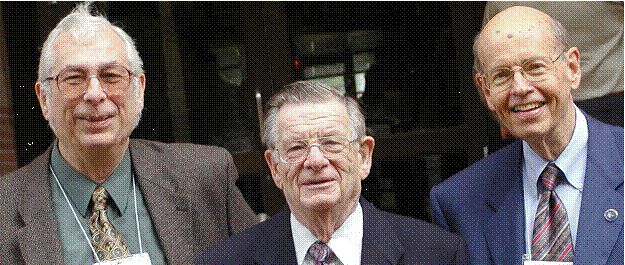

ADI pioneers Douglas, Peaceman and Rachford.
A meeting in Rice University, Houston celebrated the 50th anniversary of the publication of a seminal paper* on the alternating direction implicit method (ADI) for solving differential equations. The authors, Jim Douglas, Don Peaceman and Henry Rachford, working for the Humble Oil Co (later Exxon) were among the first to use computers to model oil reservoirs.
Ice Box
Their method’s ingenuity lay in the way it adapted a multidimensional problem to a sequence of one dimensional steps that fitted into the extremely limited memory of the IBM calculator. As described in Paul Davis’ excellent review of ADI development**, the method involved punching intermediate data onto cards backwards and upside down. These were turned over and read in backwards, reversing the direction of computation.
Watts
Bill Watts (Exxon) described ADI as the best available method until the late 60s when strongly implicit procedures, LSOR Krylov space methods ‘changed the world of solving matrix equations’. Now, Krilov, ILU, nested factorization, Line SOR and multi grid methods are used. But for today’s large, complex reservoir models, ‘We are still feeling our way,’ seeking a balance between compute efficiency, algorithm stability and accuracy.
Rachford
Henry Rachford, who now works for BG spin-off Advantica, told Oil IT Journal more about the hardware used. ‘The IBM Card Programmed Calculator (CPC) was a cobbled-together collection of existing IBM equipment including an accounting machine printer and card reader (I think it was a 407***), and a relative of the 605 calculating punch, the system’s plug-wired ‘CPU’. It had three storage units which we called ‘iceboxes,’ because once stored, data couldn’t be retrieved in under 400ms, so it got pretty ‘cold’. Each stored a collection of 16 signed 10-decimal digit numbers. Three iceboxes stored 48 10-digit numbers, which we formatted as a 2-digit exponent and 8-digit mantissa. The 407 provided storage for an additional 8 internal 10-digit decimal numbers for a total of 56. This limited the first test of ADI on the CPC to a 14 x 14 grid. Don Peaceman and I did all the coding which turned these accounting machines into card-instruction-interpreters for performing somewhat restricted floating point calculations including log and exponentials, but no trig. Insofar as I know our particular version of this computing system was never made available outside our office.’
* Journal of the Society for Industrial and Applied Mathematics, Vol. 3, pages 28-41.
** SIAM News, Vol. 26, No. 4, July 1993.
*** www.columbia.edu/acis/history/407.html.
© Oil IT Journal - all rights reserved.